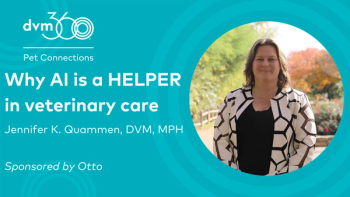
National Dog Bite Prevention Week efforts focus on COVID-19 pandemic
Our current state of affairs affects companion animals as well as the people who care for them. The National Dog Bite Prevention Week Coalition outlines why it’s more important than ever to incorporate dog bite prevention education into client communication.
It’s National Dog Bite Prevention Week, a time when the veterinary and insurance industries join forces to promote education and responsible pet ownership. In light of the ongoing COVID-19 pandemic and the trickle-down effect it is having on companion animals, this year’s message has been tailored to include information about caring for dogs during this extended period at home.
Not recognizing signs of distress or failing to provide a dog with a safe place to retreat could result in unexpected bites, warns the National Dog Bite Prevention Week Coalition. This week, the coalition hosted “Sheltering safely with pets at home,” a webinar that featured representatives from the American Veterinary Medical Association (AVMA), American Humane, State Farm Insurance and the Insurance Information Institute, as well as dog trainer, author and TV personality Victoria Stilwell.
“These are challenging times for all of us,” said John Howe, DVM, AVMA president. “We are living in closer quarters, we are spending more time together and our routines are really no longer routine. All of us, including our pets, are living a new norm and we all at times need our own space.”
Dog bite statistics
It is estimated that more than 17,800 dog bites occur annually in the United States. According to the Insurance Information Institute, dog bites resulted in homeowners’ insurance payouts of $796.8 million in 2019—a 2.9% increase over the previous year.
The states with the highest reported dog bite rates are California, Florida, Texas, New York and Illinois. And while the national average for insurance claims related to a dog bite is $44,760, New York’s average topped them all at $55,801 per claim. These data illustrate why pet owners must take the time to learn to recognize their dog’s behavior, said Janet Ruiz, strategic communications director for the Insurance Information Institute. “By owning a dog, you are responsible if it bites or injures another person.”
Offering your expertise
The AVMA encourages veterinarians to incorporate dog bite prevention education into their client communications. “Whether enjoying the company of a longtime companion or a new addition, we should all be aware of the stress that can lead to dog bites,” Dr. Howe said. “As veterinarians, we have a professional and ethical obligation to address the issue of dog bites and we can help minimize the occurrence of dog bites by helping to educate the pet-owning public about what they can do to preserve and enhance the human-animal bond.”
Although non-emergency office visits are currently on hold in most states, there are other available avenues of communication between veterinary hospitals and their clients. To reach your general client base, consider email newsletters with a focus on how to ensure pets and their families continue to live harmoniously while spending this extra time at home. Keep in touch with your clients through social media posts that offer educational tools via videos, infographics and articles.
Share some of these tips from the National Dog Bite Prevention Week Coalition with your client base:
- “One of the most important ways to prevent dog bites is to understand dog body language,” said Stilwell. This includes visual (ears back, shaking), acoustic (growling, barking) and chemical (urinating where it is not supposed to) behaviors.
- Avoid rough play with humans, toys and other animals.
- Dogs need their own space. This “safe zone” could be a bed, a crate with the door open or an entire room. Establishing this area is especially important now that entire families are spending more time together at home.
- Focus on positive reinforcement to maximize the behaviors you want while minimizing those you do not.
- When adopting a new pet, educate all family members on animal safety to ensure the pet is not overwhelmed with too much attention before it is ready. “Respect that a dog’s physical space is very important as it learns to trust you,” said Lesa Staubus, DVM, a rescue veterinarian with American Humane. “The entire family needs to understand that the animal is capable of biting.”
- Monitor all interactions between children and pets. They should never be left together unattended.
- Prepare your home for a new pet so that the dog has privacy and time to rest. “These animals have often gone through so much on their way through the sheltering system before they enter a new home,” Dr. Staubus said.
- Educate all family members on key signs of canine distress, including ears back, tail tucking, shaking or trembling, mouth open to show teeth and lunging.
- Offer food and meals in a safe space where the pet does not feel threatened by the presence of humans or other animals.
- “Be your dog’s advocate,” Stilwell encouraged. If your pet is showing signs that it is uncomfortable, calmly and carefully remove it from the situation.
If your hospital staff is unable to create original content for clients, take advantage of the plethora of educational materials available to the veterinary community. Beyond the related content on
In addition to mass correspondence, continue to respond to emails and phone calls from clients and, when applicable, conduct telehealth appointments to discuss behavioral changes patients might be exhibiting. Providing proactive information reminds clients that even without face-to-face interactions, their pets remain your practice’s top priority.
Amanda Carrozza is a freelance writer and editor in New Jersey.
Newsletter
From exam room tips to practice management insights, get trusted veterinary news delivered straight to your inbox—subscribe to dvm360.






